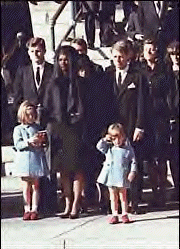District of Columbia
Related: About this forumOn this day, Monday, November 25, 1963, Washington, D.C., ground to a halt for Kennedy's funeral.
Thu Nov 25, 2021: On this day, Monday, November 25, 1963, Washington, D.C., ground to a halt for Kennedy's funeral.
I missed posting this in 2020.
Mon Nov 25, 2019: On this date, Monday, November 25, 1963, Washington, D.C., ground to a halt for Kennedy's funeral.
Hat tip to Wikipedia for the correct punctuation of Washington, D.C.
{snip}
The state funeral of John F. Kennedy, 35th U.S. President, took place in Washington, D.C., during the three days that followed his assassination on Friday, November 22, 1963, in Dallas, Texas.
{snip}
Funeral
As people were viewing the casket, military authorities held meetings at the White House, at MDW headquarters, and at Arlington National Cemetery to plan Monday's events. First, they decided that the public viewing should end at 9:00 a.m. EST and that the ceremonies would begin at 10:30 a.m. EST. On Sunday evening the State Department issued its Official Narrative of Events for November 25:
{snip}
Approximately one million people lined the route of the funeral procession, from the Capitol back to the White House, then to St. Matthew's Cathedral, and finally to Arlington National Cemetery. Millions more followed the funeral on television. Those who watched the funeral on television were the only ones who saw the ceremony in its entirety. The three networks, ABC, CBS, and NBC, used at least 50 cameras for the joint coverage in order to allow viewers to follow the proceedings in their entirety from the Capitol to Arlington. In addition, the networks' Washington bureau chiefs (Bob Fleming at ABC, Bill Monroe at NBC, and Bill Small at CBS) moved correspondents and cameras to keep them ahead of the cortège.
The day's events began at 8:25 a.m., when the MPDC cut off the line of mourners waiting to get into the rotunda. They did so because a large group tried to break into the line and the MPDC were not able to sort out those who had already been in line, many of whom had waited for five hours. Thirty-five minutes, later, the doors closed, ending the lying in state; the last visitors passed through at 9:05 a.m.
At 10:00 a.m., both houses of Congress met to pass resolutions expressing sorrow. In the Senate, Maine Republican Senator Margaret Chase Smith laid a single rose on the desk Kennedy had occupied when in the Senate.
{snip}
Procession to cathedral

The riderless (caparisoned) horse named "Black Jack" during a departure ceremony held on the center steps at the United States Capitol Building.

A limbers and caissons bearing the casket of United States President John F. Kennedy seen moving down the White House drive on the way to St. Matthew's Cathedral on November 25, 1963. A color guard holding the presidential colors, the flag of the President of the United States, and the riderless horse "Black Jack", follow behind.
After Jacqueline Kennedy and her brothers-in-laws, Attorney General Robert Kennedy and Massachusetts Democratic Senator Ted Kennedy, visited the rotunda, the coffin was carried out onto the caisson. At 10:50, the caisson left the Capitol. Ten minutes later, the procession began, making its way back to the White House. As the procession reached the White House, all the military units except for the Marine company turned right off Pennsylvania Avenue and onto 17th Street. A platoon of the Marine company turned in the northeast gate and led the cortege into the North Portico.
At the White House, the procession resumed on foot for roughly 0.9 miles (1.4 km) to St. Matthew's Cathedral, led by Jacqueline Kennedy and the late president's brothers, Robert and Edward (Ted) Kennedy. They walked the same route that John F. Kennedy and Jacqueline Kennedy often used when going to Mass at the cathedral. This also marked the first time that a first lady walked in her husband's funeral procession. The two Kennedy children rode in a limousine behind their mother and uncles. The rest of the Kennedy family, apart from the president's father, Joseph P. Kennedy Sr., who was ill, waited at the cathedral.
The new president Lyndon B. Johnson, his wife Lady Bird, and their two daughters Luci and Lynda also marched in the procession. Johnson had been advised not to do so because of the potential risk in the wake of Kennedy's assassination. Johnson recounted his experiences in his memoirs, saying, "I remember marching behind the caisson to St. Matthew's Cathedral. The muffled rumble of drums set up a heartbreaking echo." Merle Miller quoted him as having said, "Walking in the procession was especially one of the most difficult decisions I had to make," but it was something he "could do, should do, would do, and did so." When he moved into the Oval Office the next day, there was a letter from Mrs. Kennedy on his desk, thanking him for walking in the procession.
Not since the funeral of Britain's King Edward VII, in 1910, had there been such a large gathering of presidents, prime ministers, and royalty at a state funeral. In all, 220 foreign dignitaries, including 19 heads of state and government, and members of royal families from 92 countries, five international agencies, and the papacy attended the funeral. Most of the dignitaries passed unnoticed, following respectfully behind the former first lady and the Kennedy family during the relatively short walk to the cathedral along Connecticut Avenue.
As the dignitaries marched, there was a heavy security presence because of concerns for the potential assassination of so many world leaders, the greatest being for French President Charles de Gaulle, who had specific threats against his life. Under Secretary of State George Ball manned the operations center at the State Department with the goal of ensuring that no incident occurred.
NBC transmitted coverage of the procession from the White House to the cathedral by satellite to twenty-three countries, including Japan and the Soviet Union, allowing hundreds of millions on both sides of the Iron Curtain in Europe to watch the funeral. Satellite coverage ended when the coffin went into the cathedral. In the Soviet Union, their commentators said that "the grief of the Soviet people mingles with the grief of the American people." There was no coverage in East Germany, where television audiences had only a soccer match to watch. In Ireland, coverage of the funeral was broadcast live by the television service, Teilifís Éireann to the Irish audience via Telstar satellite. The Irish audience were only able to see the 25 minutes that showed President Kennedy's coffin being brought to St. Matthew's Cathedral. The Irish television audiences also did not see all of the footage live but Michael O'Hehir's audio commentary remained available to them throughout. In Britain, coverage of the funeral was broadcast by both BBC and ITV who also screened the funeral live via Telstar. BBC's leading news commentator, Richard Dimbleby, gave live commentary of the funeral on BBC, while ITN journalist and broadcaster, Alastair Burnet gave live commentary of the funeral on ITV.
The widow, wearing a black veil, led the way up the steps of the cathedral holding the hands of her two children, with John Jr., whose third birthday fell on the day of his father's funeral, on her left, and Caroline on her right. Because of the funeral and the day of mourning, the widow postponed John Jr.'s birthday party until December 5, the last day the family was in the White House.
{snip}

John F. Kennedy, Jr. salutes his father's coffin while standing next to Jacqueline Kennedy, who is holding Caroline Kennedy's hand; Senator Ted Kennedy and Attorney General Robert F. Kennedy are seen behind them.
{snip}
There are any number of videos of the funeral. Start here:
https://www.youtube.com/results?search_query=president+kennedy+funeral
Don't miss this thread:
Sat Nov 23, 2013: Black Jack, the Caparisoned horse at JFK Kennedy 's funeral
katmondoo
(6,521 posts)Walleye
(43,532 posts)I can see it now it was saturation coverage like we don’t understand these days. Three networks that’s all there was. I think it was the first time I felt the weight of collective grief and fear. Nothing was really the same after that in American politics. And then all the shit hit the fan.
murielm99
(32,568 posts)It seems like yesterday.
I remember my church having better attendance for a few weeks, too. People clung to everything they could find for comfort.
Walleye
(43,532 posts)mahatmakanejeeves
(67,847 posts)Link to tweet